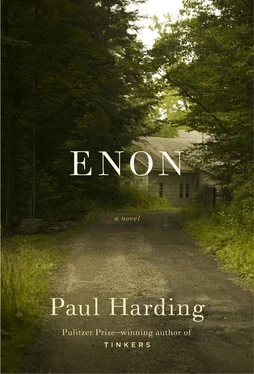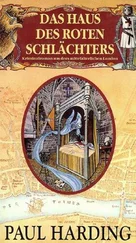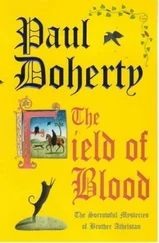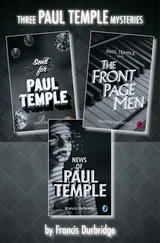Paul Harding - Enon
Здесь есть возможность читать онлайн «Paul Harding - Enon» весь текст электронной книги совершенно бесплатно (целиком полную версию без сокращений). В некоторых случаях можно слушать аудио, скачать через торрент в формате fb2 и присутствует краткое содержание. Жанр: Современная проза, на английском языке. Описание произведения, (предисловие) а так же отзывы посетителей доступны на портале библиотеки ЛибКат.
- Название:Enon
- Автор:
- Жанр:
- Год:неизвестен
- ISBN:нет данных
- Рейтинг книги:3 / 5. Голосов: 1
-
Избранное:Добавить в избранное
- Отзывы:
-
Ваша оценка:
- 60
- 1
- 2
- 3
- 4
- 5
Enon: краткое содержание, описание и аннотация
Предлагаем к чтению аннотацию, описание, краткое содержание или предисловие (зависит от того, что написал сам автор книги «Enon»). Если вы не нашли необходимую информацию о книге — напишите в комментариях, мы постараемся отыскать её.
Powerful, brilliantly written, and deeply moving Paul Harding has, in Enon, written a worthy successor to Tinkers, a debut which John Freeman on NPR called "a masterpiece." Drawn always to the rich landscape of his character's inner lives, here, through the first person narrative of Charlie Crosby (grandson to George Crosby of Tinkers), Harding creates a devastating portrait of a father trying desperately to come to terms with family loss.
Enon — читать онлайн бесплатно полную книгу (весь текст) целиком
Ниже представлен текст книги, разбитый по страницам. Система сохранения места последней прочитанной страницы, позволяет с удобством читать онлайн бесплатно книгу «Enon», без необходимости каждый раз заново искать на чём Вы остановились. Поставьте закладку, и сможете в любой момент перейти на страницу, на которой закончили чтение.
Интервал:
Закладка:
I winked and nodded my head in Kate’s direction. “I think we both need an ice cream, Mom.”
“I think we all do,” Susan said. She came around and hugged Kate and kissed her head and Kate hugged her back, her hair matted and damp. “Okay, my Kat. Let’s pack up the gear and go to Dick and June’s for an ice cream.” She wheeled Kate’s bike to the car and I put it in the back with mine. I hopped into the passenger seat and kissed Susan on the cheek and said, “My undying appreciation and loyalty to you for rescuing us, milady.”
Susan rolled her eyes. “ ’Twas nothing, milord . Let’s go get a frappe.”
Susan pulled the car onto the road and made a U-turn and headed toward the ice cream place. I looked at Enon Lake and thought about what pottery and arrowheads and people must be under its silty floor.
“That stand of beech trees, right over there? That’s where the icehouses used to be,” I said to Susan.
“It seems so crazy that they shipped the ice to England,” she said.
“We’re being bad,” I called back to Kate. “We’re having ice cream for dinner. What flavor are you going to get, babe? Maple walnut? Strawberry?” Kate didn’t answer. Susan looked up into the rearview mirror and nodded for me to look, too. I turned around and saw Kate curled up on the back seat, her hair trailing over her face, asleep.
IF YOU LOOK AT the side of the hill between the sixth and seventh holes of the Enon Golf Club, west of the cemetery, you can still see traces of the foundation of the town’s only windmill. The windmill burned down in 1661. Farther down the hill, by the road, near the putting green for the tenth hole, stood the house of the father of Sarah Good, who was condemned as a witch and hanged down the road in Salem in 1692, and who famously told her accuser that God would give him blood to drink. I wondered if the girls I had seen in the cemetery knew this. I imagined it would please them, that they’d feel an immediate kinship with her, like Kate always had from the first time I told her about the witch trials, perhaps one that ran deeper than their usual teenage sense of persecution. I read about Sarah Good in an old history of the town, published in 1823, for the town’s bicentennial. It was striking that at that time the author of the book, a man named Barnet Wood, already considered Sarah Good a part of the town’s remote history. I liked to think about the fact that he wrote his book one hundred and seventy-five years before I read it, and that Sarah Good met her fate one hundred and thirty-one years before he wrote it. Sarah was hanged in Salem, but there were nights when I passed through the center of the village and imagined Sarah swinging in the wind from a gallows where the Civil War memorial is, which was originally a green used for common pasturage. The statue standing atop the pediment of the memorial is modeled after a man named Benjamin Conant, who fought in the Union Army and was famous for the grapevines he kept, and who repaired shoes before and after the war out of a small shack behind one of the larger houses along Main Street; the shack is still there and is now used as a tool shed by a dentist. Benjamin Conant’s statue was erected in 1870, while he was still alive, forty-seven years after Barnet Wood published his book A History of Enon, on the Occasion of Its Bicentennial , one hundred and seventy-eight years after Sarah Good was hanged in Salem, thirty years after the first Crosby settled in Enon, and one hundred and thirty-five years before my daughter was buried half a mile up the street. In fact, Barnet Wood and Benjamin Conant are both buried in the cemetery as well. I don’t know where Sarah Good was buried — maybe in Salem. I never looked it up. But the woods of Enon are full of very old unmarked graves and hers may well be among them, along with the bones of animals and citizens: sheep and dogs, fathers and brothers, oxen and horses, mothers and aunts, pigs and chickens, sons and daughters, anonymous cats and owls, Puritans and Indians, and unnamed infants, getting their bones mixed in the currents of soil and groundwater, migrating beneath the foundations of our houses and the fairways of the golf courses, trading ribs and teeth and shins and knuckles, commuting under baseball diamonds and the beds of streams, snagging up on roots and rocks, shelves of granite and seams of clay. There are certainly more citizens of Enon beneath its fifty-four hundred acres than there are above it. Just beneath our feet, on the other side of the surface of the earth, there is another, subterranean Enon, which conceals its secret business by conducting it too slowly for its purposes to be observed by the living.
IT WAS EASY FOR me to imagine Kate living in an Enon that existed in the past, though, where all the citizens from all the village’s history lived among one another. I could see her newly arrived, walking alone down Main Street, between the cemetery and town hall — the Memorial Day parade route, I guessed. I saw her as having come from the beach a mile away, not from the sunbathing she’d done with Carrie right before she died but from a landing, a disembarkation after a trip across another Atlantic.
Kate has dried in the breeze but her skin is salted and her hair, clothes, and beach towel brined. She is pale and still wobbly on her feet from the weeks of the rise and fall of the trip across the ocean, and still feels nauseated from the seasickness she suffered most of the way. The details of the shore and the dark boat that brought her are imprecise, beyond the boundaries of this other Enon. I knew that the boat turned back after its crew saw Kate safely ashore and that by the time she entered the village it had sailed beneath the horizon to fetch more pilgrims.
Main Street is unpaved and called the Turnpike. A dog, a terrier, trots out onto the road from the high corn that grows in a field belonging to the farm opposite the cemetery. It approaches Kate and barks and grins.
Kate crouches down and says, “Hi, boy,” to the dog and scratches it behind the ear. The dog is small, a descendant of the first terriers the villagers must have kept in order to help control rats. Kate takes a corner of the hard yellow corn bread she has rolled up in the beach towel and offers it to the dog. The bread must be old and stale and salty, the last of Kate’s rations from the crossing. The dog sniffs at the bread, looks up at Kate, yawns, shakes itself, and trots off, toward a low brown house with a high roof and small windows fitted with diamond-shaped panes of leaded glass. The house stands alone, behind a stone wall running along the road. The front door of the house is closed, and when Kate gets to it and knocks, no one answers. She walks around to the back of the house. There is a dirt yard and a garden planted with Good-King-Henry and purslane, smallage and skirrets, and other obscure herbs dotted with black and midnight purple flowers that have prickly, hairy leaves the color of bats’ wings. Kate does not recognize any of the plants. There is a pile of wood stacked against the back wall. Kate turns from the house and looks up the hill, which appears to be used for pasturage. It is late afternoon and shadows are long. A quartet of goats are making their way across the summit of the hill, slowly, in single file, and their thin shadows stretch at oblique angles ahead of them in parallel lines down the length of the hill, as if they are puppets being marched along the crest of a stage at the ends of long black sticks. Halfway up the hill, there is a girl, two or three years older than Kate, sitting on a stump, with her elbows on her knees, one hand curled into a fist, on which she rests her chin, the other hand extended and open, palm up, in which a small yellow bird is perched, eating thistle seeds. She wears a black dress that Kate finds archaic and beautiful, and black leather shoes with wooden heels. Kate knows the girl from all the town history I’ve told her over the years, stories that bored her in themselves but that she loved to hear because she loved that I loved them and that I loved telling them to her. Despite the girl’s later, infamous role in local history, after she had grown up and found herself homeless and spent her days scolding her neighbors for being uncharitable, Kate was loyal to her from the first time I told her the story and always remained so, convinced that theories about her hysteria and madness were the kind of humbuggery that always suppresses and deforms the spirits of strong young girls. Kate knows that the girl has seen her, or at least is aware that she is there, even though the girl has not moved. Kate knows, too, that the girl does not move or gesture toward her because she already knows that Kate will approach her. Kate walks across the yard and into the pasture and up the hill and stands in front of the girl, who looks up, squinting in the light of the late, low, orange sun. There is a cooling, gusty breeze that makes the flowers and the long, stiff grass shiver. The pasture smells like grass and open earth and, faintly, dung.
Читать дальшеИнтервал:
Закладка:
Похожие книги на «Enon»
Представляем Вашему вниманию похожие книги на «Enon» списком для выбора. Мы отобрали схожую по названию и смыслу литературу в надежде предоставить читателям больше вариантов отыскать новые, интересные, ещё непрочитанные произведения.
Обсуждение, отзывы о книге «Enon» и просто собственные мнения читателей. Оставьте ваши комментарии, напишите, что Вы думаете о произведении, его смысле или главных героях. Укажите что конкретно понравилось, а что нет, и почему Вы так считаете.












